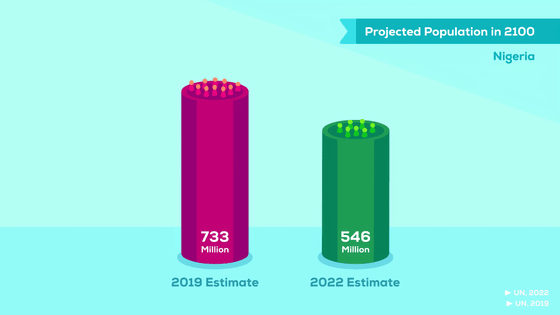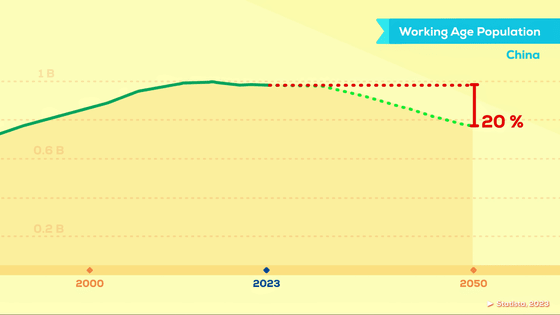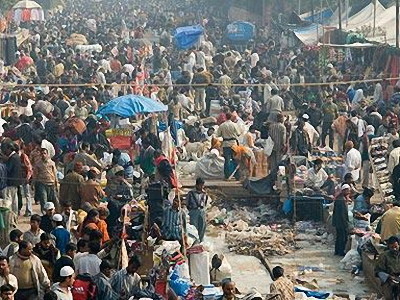What problems will arise as the world population declines?

Although the world's population has reached 8 billion people and continues to increase, there are countries such as Japan and South Korea whose populations are decreasing year by year. Kurzgesagt, a scientific YouTube channel, explained how countries and regions will change if population decline spreads, and whether there are countermeasures.
For a long time, population growth was slow due to epidemics and wars. However, since the rapid progress brought about by the Industrial Revolution, the number of people has continued to increase exponentially, reaching 6 billion people in 1999 and 8 billion just 24 years later.

Population growth is expected to continue until at least 2080, but Kurzgesagt points out that ``this prediction underestimates the human birth rate.''

To maintain the current population, each couple needs to have two children on average. If this number is high, the population will increase; if this number is low, it will decrease. South Korea is the only country where this number is less than 1.

As of 2022, South Korea's birth rate is 0.8, the lowest in the world.

This means that 40 children will be born to 50 couples (100 people), 16 children will be born after those 40 are of marriageable age, and 6 children will be born to those 16... This leads to the following calculations.

This could cause South Korea's population to decline to around 1950 levels by 2100.

There is some optimism that the population will simply return to its previous level, but the problem lies in the demographic structure. In 1950, the median age in South Korea was 18 years old.

This value is predicted to be 45 years old in 2023 and 59 years old in 2100. South Korea will be a country of elderly people.

China may follow suit. China's population has increased explosively due to rapid industrialization and urbanization, but with the one-child policy aimed at slowing population growth, each family has come to prefer smaller families. This has kept China's birth rate at a low level for decades.

China's population is also expected to decline significantly by 2100.

China's birth rate is one of the lowest among East Asian countries, and Japan's is similarly low.

Looking at Europe, although like Asia it has a low birth rate, its population is declining at a slower pace. This is due to the influx of immigrants, but another problem is that many of the immigrants are coming from countries with low birth rates.

Furthermore, as many immigrants move to economically strong countries like Germany, the overall population decline is accelerating. The average age in Europe is 46 years old, one of the highest in the world.

Fertility rates remain high in the northern Middle East and sub-Saharan Africa, with most places exceeding 2.

On the other hand, the United Nations has lowered its prediction that Africa's population will reach 733 million by 2100 to 546 million, and attention has been drawn to the fact that the birth rate is falling faster than expected. Masu.

A healthy society needs people of prime working age more than anything. In the past, the social structure of the world was such that many young people took care of a few elderly people, but a reversal is already occurring where many elderly people are supported by a few young people.

Even in wealthy countries, the economic burden on young people is enormous and eventually becomes unsustainable. In China, for example, the working-age population is expected to decline by 20% by 2050, reaching up to 200 million people.

A decline in the working-age population will first lead to a decline in infrastructure. This is already happening in rural Germany and Japan.

Another danger of an aging society is that elected officials may be more likely to listen to the voices of older people. Seeking wealth preservation over innovation for older people leaves us unable to address problems that require huge investments and fresh ideas.

Kurzgesagt states that ``the easiest way to prevent the decline in the birth rate is to invite immigrants,'' but since the birth rate of immigrants declines over three generations, it is necessary to constantly accept immigrants in order to maintain the population. It seems that there is. Furthermore, considering the population of the country from which the immigrants are flowing, it is not a sustainable method after all.

Immigration can also create social or cultural tensions. This is a universal phenomenon in any culture.

There is also the problem that raising children can hinder one's career, and the rapidly increasing trend of individualism in recent years means that more and more people are not trying to find a partner in the first place.

Kurzgesagt says, ``At the very least, we have to stop raising children as a barrier to careers, making parents' lives better, making housing cheaper, etc.'' We need to build a culture.”

Related Posts:
in Video, Posted by log1p_kr







